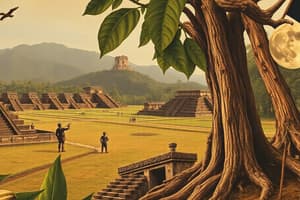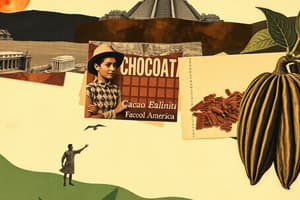Podcast
Questions and Answers
What was the original use of cacao by the Maya people?
What was the original use of cacao by the Maya people?
- For religious rituals (correct)
- For funerary offerings
- As medicine
- As currency
Which country was the first to have a chocolate company?
Which country was the first to have a chocolate company?
- Mexico
- France (correct)
- England
- Spain
What was the original use of chocolate by the Aztecs?
What was the original use of chocolate by the Aztecs?
- As medicine
- As currency
- As a court favorite
- As an aphrodisiac (correct)
Who invented milk chocolate?
Who invented milk chocolate?
What did Dutch chemist Coenraad van Houten do to chocolate?
What did Dutch chemist Coenraad van Houten do to chocolate?
What was the original use of chocolate before it became popular in Europe?
What was the original use of chocolate before it became popular in Europe?
What was the impact of the invention of the press by Coenraad van Houten?
What was the impact of the invention of the press by Coenraad van Houten?
What was the impact of the conching machine invented by Rodolphe Lindt?
What was the impact of the conching machine invented by Rodolphe Lindt?
What was the original use of cacao by the Mayo-Chinchipe culture?
What was the original use of cacao by the Mayo-Chinchipe culture?
Flashcards
Mesoamerican Cacao Drink
Mesoamerican Cacao Drink
A bitter drink made with cacao, spices, and corn puree, used in Mesoamerica, believed to give strength and act as an aphrodisiac.
Origin of "Chocolate"
Origin of "Chocolate"
Classical Nahuatl word of uncertain etymology, origin of the English word chocolate. Entered English language via the Spanish language.
Cacao Pod
Cacao Pod
Cacao pods grow in various colors and textures, containing 30-40 brownish-red, almond-shaped beans in sweet pulp.
Maya Use of Cacao
Maya Use of Cacao
Signup and view all the flashcards
Quetzalcoatl
Quetzalcoatl
Signup and view all the flashcards
Coenraad van Houten
Coenraad van Houten
Signup and view all the flashcards
J. S. Fry & Sons
J. S. Fry & Sons
Signup and view all the flashcards
Rodolphe Lindt
Rodolphe Lindt
Signup and view all the flashcards
Ivory Coast Cocoa
Ivory Coast Cocoa
Signup and view all the flashcards
Study Notes
History of Chocolate: From Mesoamerica to Europe
-
Cacao was first discovered and used in Mesoamerica where it was consumed as a bitter drink mixed with spices and corn puree, believed to be an aphrodisiac and to give strength.
-
Cacao seeds were so valuable that they were used as a form of currency by the Mexica.
-
Chocolate arrived in Europe in the 16th century where sugar was added, making it popular among the ruling classes and then among the common people.
-
Chocolate was considered essential in the rations of United States soldiers during war in the 20th century.
-
The word "chocolate" comes from the Classical Nahuatl word xocolātl, of uncertain etymology, and entered the English language via the Spanish language.
-
Cacao pods grow in a wide range of colors and textures, with 30 to 40 brownish-red almond-shaped beans embedded in a sweet viscous pulp.
-
Evidence suggests that cacao was fermented and served as an alcoholic beverage as early as 1400 BC.
-
Cacao was originally domesticated in South America and used by the Mayo-Chinchipe culture between 5,300 and 2,100 years ago.
-
The Maya people used cacao for religious rituals, funerary offerings, tribute, and medicinal purposes and used cacao beans as currency.
-
The Aztecs associated cacao with the god Quetzalcoatl and drank it cold, consuming it as an aphrodisiac or as a treat for men after banquets.
-
Chocolate was initially used as a medicine to treat illnesses such as abdominal pain because of its bitterness, but once sweetened, it became a court favorite.
-
The desire for chocolate created a thriving slave market, and with the depletion of Mesoamerican workers, cocoa beans production was often the work of poor wage laborers and enslaved Africans.The History and Modern Use of Chocolate
-
Water-powered edge runners were used to crush cacao beans on a larger scale than before.
-
The patent for a chocolate refining process was bought in 1761 by Joseph Fry, who started J. S. Fry & Sons.
-
Wind-powered and horse-drawn mills were used to speed up production, and heating working areas assisted in extraction.
-
Chocolaterie Lombart, created in 1760, was the first chocolate company in France, 10 years before Pelletier et Pelletier.
-
Dutch chemist Coenraad van Houten introduced alkaline salts to chocolate in 1815, reducing bitterness. He also created a press to remove half the natural fat from chocolate liquor in 1828, making it cheaper to produce and consistent in quality.
-
In 1847, J. S. Fry & Sons made chocolate moldable by adding melted cacao butter. Milk chocolate was invented in 1875 by Daniel Peter by mixing powdered milk with liquor.
-
Rodolphe Lindt invented the conching machine in 1879, improving the texture and taste of chocolate.
-
Cadbury started manufacturing boxed chocolates in England by 1868, and Milton S. Hershey began the career of Hershey's chocolates with chocolate-coated caramels in 1893.
-
The production of chocolate shifted from the New World to Asia and Africa, and the price dropped dramatically in the 1890s and 1900s.
-
Roughly two-thirds of the world's cocoa is produced in Western Africa, with Ivory Coast being the largest source.
-
Individual cocoa farmers are at the mercy of volatile world markets, and only three to four percent of cocoa futures contracts traded ever end up in physical delivery.
-
Seven to nine times more cocoa is bought and sold on the exchange than exists.
Studying That Suits You
Use AI to generate personalized quizzes and flashcards to suit your learning preferences.




